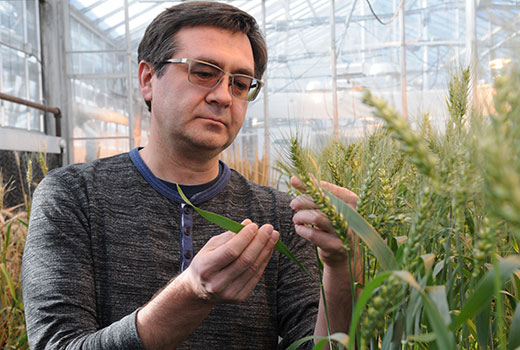
Eduard Akhunov, K-State professor of wheat genetics and pathology, looks at wheat spikes in the university’s greenhouse. | Download this photo.
Kansas State University researchers using gene-editing technology to improve wheat
Their work is featured in the inaugural issue of the CRISPR Journal
February 27, 2018
MANHATTAN, Kan. – Kansas State University researchers say their work to improve genes in wheat varieties using a gene-editing technology is another positive step toward global food security.
“Food security and the food supply is one of the main issues in the world’s future,” said Eduard Akhunov, professor of wheat genetics and pathology. “With the increasing population size and a decline in the amount of land available for growing crops, we really need to intensify agriculture in a sustainable way.”
Akhunov and his colleagues are working with gene editing, a technology developed five years ago which can be used to modify with high precision any gene in a living organism. Their work with wheat is featured in the inaugural issue of the CRISPR Journal, which was released in mid-February.
CRISPR-Cas9 technology, introduced in 2012, is a simple yet powerful tool for editing genomes, the complete set of genetic material present in a cell. Akhunov said it allows researchers to easily change DNA sequences, creating new variants of a gene with improved properties, or fix known defects in a gene.
“You can consider CRISPR-Cas9 to be like molecular scissors that can make changes very precisely in a particular place of the genome,” Akhunov said. “Using this tool, you can selectively modify any part of a genome to improve genes controlling major agronomic traits.”
This same process is done in traditional wheat breeding, he added, but it often takes as many as 7-10 years to effect the improvements that CRISPR technology can enact in a much shorter time.
“Traditional breeding involves screening existing germplasm (genetic material) collections for genetic variation that is useful, and then introducing it into wheat varieties to improve a trait,” Akhunov said. “This process can be time-consuming and may fail if the specific genetic variation is not present in the screened germplasm.”
“CRISPR-Cas9 technology can use the knowledge we have already collected about the gene’s biology to introduce changes into the functionally important regions of a gene. These new variants of a gene can bring new traits, broadening the useful genetic variation that currently exists in the germplasm collections.”
Akhunov noted that K-State researchers work with a suite of 25 genes controlling traits that have the potential to affect yield. Using CRISPR-Cas9 technology, they have the ability to improve each of these genes before testing them in the greenhouse, and eventually evaluating them in field conditions.
“Once we identify genes that beneficially affect yield-related traits in wheat, we will work with wheat breeders to transfer these gene-editing advances to top varieties grown here in Kansas, and other U.S. breeding programs,” he said.
To achieve this, the K-State scientists will cross a wheat line containing a CRISPR-Cas9 enzyme with wheat cultivars that do not contain the enzyme.
“In the progeny (or offspring) of this cross, we select only those plants that do not have the CRISPR-Cas9 enzyme, but carry the change in the genome that we wanted to induce,” Akhunov said.
Thus, he added, nothing new is added to the resulting wheat variety, only an improvement in the performance of the wheat’s genes.
“The same outcome can happen due to natural mutations (in wheat varieties) over time, but we are accelerating this process, using CRISPR-Cas9, that can induce mutations in one specific place in the genome,” Akhunov said. “Hypothetically, if you would wait several million years, or screen thousands and thousands of wheat lines collected across the globe, you will likely recover mutations in the same location in the genome that will have the same effect on gene function. But by using the CRISPR-Cas9 technology, you can achieve it in a single wheat line within a year.”
Specific to wheat, Kansas State scientists are working to improve genes that control several yield component traits, among them seed size, number of seeds per spike and the number of tillers per plant.
“We systematically go gene by gene, modifying them using the CRISPR-Cas9 system and then we test to find out which changes in the wheat genome result in increased yield,” Akhunov said.
K-State’s work on the CRISPR-Cas9 technology is led by Akhunov and funded by the Agriculture and Food Research Initiative competitive grant from the USDA National Institute of Food and Agriculture. The project is a part of the International Wheat Yield Partnership (iwyp.org) program aimed at increasing the genetic yield potential of wheat using innovative approaches.
The researchers’ paper in the inaugural issue of the CRISPR Journal can be found at http://online.liebertpub.com/doi/pdfplus/10.1089/crispr.2017.0010.

